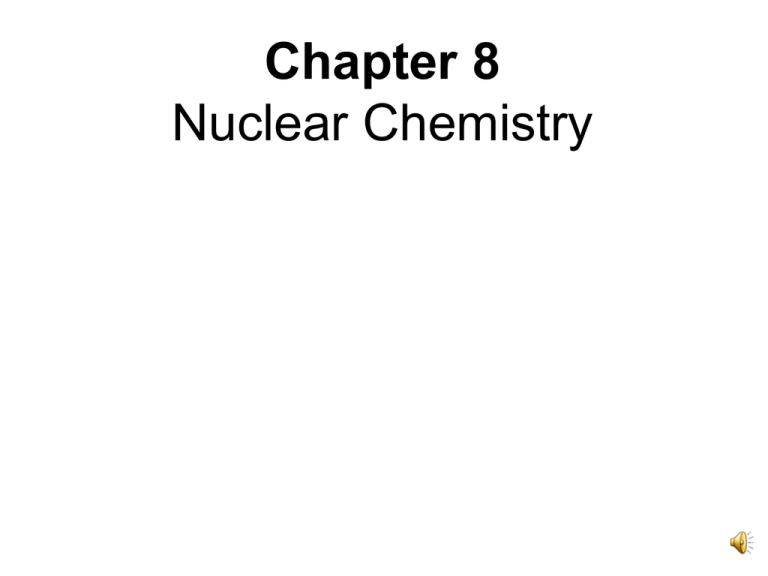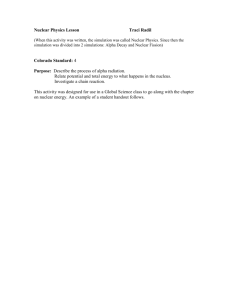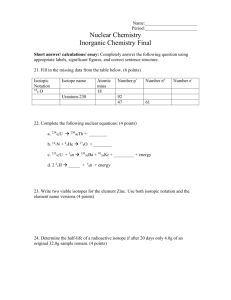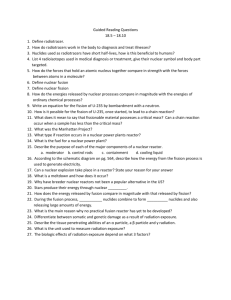Chapter 8
advertisement

Chapter 8 Nuclear Chemistry Radiation • The emission of energetic particles • The study of it and the processes that produce it is called nuclear chemistry. • Unlike the chemistry we have studied to this point, nuclear chemistry often results in one element changing into another one. Tragedy • • • • • April 26, 1986, 1:24 am V.I. Lenin nuclear power plant Chernobyl, USSR Explosions in reactor 4 31 immediate deaths, 230 hospitalizations, countless exposures to high level radiation • The aftermath continues to this day. • Ordinary chemistry – Atomic and molecular changes involving electrons – Attainment of the stable octet configuration • Nuclear chemistry – Atomic changes involving the nuclei – Nuclei emit energetic particles we call radiation Becquerel • Discovered that his paper-wrapped photographic plate was exposed by uranium-containing crystals… • Which disproved his hypothesis linking the exposure to UV light and phosphorescence… • But it revealed a brand new phenomenon which he termed the emission of uranic rays Curie • Discovered two new emitters of uranic rays, one was a new element (polonium) • Since the rays were not unique to uranium, a new term – radioactivity Radioactivity • Characterized by Rutherford • The result of nuclear instability Alpha Radiation • Composed of two protons and two neutrons • Represented by the symbol for a helium nucleus • High ionizing power • Low penetrating power Beta Radiation • An energetic electron represented by the symbol (beta particle symbol here) • Smaller than alpha particles, so more penetrating • But this also means less ionizing power In beta decay, a neutron converts to a proton, emitting an electron and increasing the atomic number by 1. Gamma Radiation • An energetic photon emitted by an atomic nucleus • Represented by the symbol • Gamma rays are electromagnetic radiation, not matter. • Highest penetrating power, lowest ionizing power ISOTOPE STABILITY • some isotopes are more stable than others • -nuclear stability correlates with the ration of protons in the isotope (proton/neutron ration of 1 is stable) • -nuclei with greater than 84 protons tend to be unstable • -isotopes containing 2, 8, 20, 50, 82, or 126 protons or neutrons are stable (indicate energy levels in nucleus) • -isotopes with even numbers of protons or neutrons are generally more stable than those with odd numbers Half-Life • The time required for half of the nuclei in a sample to decay Half-Life • What does At-212 become if a beta and a gamma particle are both emitted? • Answer: 212 At 85 212 0 + Rn -1 86 e + Balance this: Gallium 64 emits a beta particle Answer: 64 Ga 31 64 Ge 32 0 + e -1 Balance this: Polonium 210 loses an alpha particle Answer 210 Po 84 206 Pb 82 + 4 2 He Nuclear Fission • General idea: If nuclei emit particles to form lighter elements, they might also absorb particles to form heavier elements. • The result would be a synthetic element. • Fermi hoped to make a synthetic element with atomic number 93. • He detected beta emission following his neutron bombardment of uranium. • Subsequent experiments by Hahn, Meitner, and Strassman seemed to confirm Fermi’s work. Puzzling Evidence • Just before the outbreak of WWII, Hahn, Meitner, and Strassman reported that no heavier element was detected, rather two lighter ones. • Previous nuclear processes had always been incremental. • Contradicting all previous experiments in nuclear physics, they proposed a model for the fission of uranium atoms on absorption of neutrons. Large amounts of energy were also emitted during fission. • Weeks later, U-235 fission was proposed as the basis for both a chain reaction and a bomb of inconceivable power. The Manhattan Project • Could Nazi Germany develop a fission bomb? • Albert Einstein communicated this possibility to President Roosevelt. • The largest scientific endeavor of its time, the race to beat Germany to the atomic bomb was code named “Manhattan Project”. Enrico Fermi and Leo Szilard constructed the first nuclear reactor at the University of Chicago; they achieved a self-sustaining controlled fission reaction lasting 4.5 minutes. Critical Mass • Lesser masses of fissionable material will not undergo self-sustaining fission; too many neutrons are lost to the surroundings instead of being absorbed by other U-235 nuclei. • After the successful controlled reaction, the goal became the construction of a device where fission would spiral out of control. Collection and synthesis of fissionable fuel (U-235 and Pu-239) were pursued at Oak Ridge, TN and Hanford, WA. J. Robert Oppenheimer directed bomb design at Los Alamos, NM. Two designs were constructed and a successful test carried out on July 16, 1945. Two atomic bombs (one uranium and one plutonium) were dropped on Japan only weeks later. Nuclear Power • Bombs are designed such that fission escalates to produce an explosion. • Nuclear reactors are designed to produce a controlled fission reaction. – Uranium rods are interspersed with control rods of neutron-absorbing material, usually boron or cadmium. • Heat of fission boils water to produce steam which turns the turbine to produce electricity. Nuclear vs. Coal-burning Power Plants • Nuclear – Uses 100 lb. of fuel per day – Produces enough electricity for a city of 1 million people – Does not produce air pollution, greenhouse gases, or acid rain – Problems include waste disposal and accidents • Coal-burning – Uses 5 million lb. of fuel to produce an equivalent amount of energy Waste Disposal • Uranium oxide pellet fuel assemblies are replaced with fresh fuel every 18 months. • Most spent fuel is currently stored on site. • 1982 Nuclear Waste Policy Act – Established a program to build an underground nuclear waste repository • Yucca Mountain, NV is the controversial site of this much-delayed project. Nuclear Accidents • Nuclear power plants cannot detonate like nuclear explosions. – Enriched uranium at 3% U-235 vs. 90% U235 • Three Mile Island – March 28, 1979 • Chernobyl – April 26, 1986 • Superior power plant design in the U.S. has meant no accidental nuclear deaths, nevertheless public support for nuclear power is chilly. Mass Defect • Mass defect is the difference between the experimentally measured mass of an atom, and the sum of the masses of individually measured protons, neutrons, and electrons. • The missing mass was converted to energy when elements form from constituent protons and neutrons. • This energy is related to the mass defect by Einstein’s equation E = mc2. Nuclear Binding Energy • Einstein’s equation E = mc2, represents the energy that holds a nucleus together. • The highest values for this binding energy are for elements with mass numbers close to 56. • The products have higher binding energy than the reactants; it follows that the products weigh less. • The missing mass is converted to energy according to E = mc2. • This difference in binding energy is the source of the energy liberated in fission. Fusion • Like fission reactions, the products of fusion have higher nuclear binding energies, so energy is released. • Fusion releases ten times more energy per gram than fission. • Fusion is responsible for the sun’s energy and is the basis of modern nuclear weapons. Controlled Fusion • Advantages – Potential for an almost limitless source of energy for society – Less radioactive waste products – Naturally occurring deuterium in water • Disadvantages/Obstacles – High temperatures required and a lack of materials available to contain them – Current production methods consume more power than they produce. Radiation and Human Life • Radiation can destroy biological molecules. • Low-level alpha emitters present little danger externally but, once ingested, have access to internal organs. • Danger is usually overstated by the popular press. Measuring Exposure • rem – most common unit for measuring human exposure • Exposure, on average, per year, is 1/3 rem Possible Effects • The human body can repair itself and suffer no adverse effects. • Abnormal growth can begin that leads to cancerous tumors. • Damage of intestinal lining leads to radiation sickness, hampering the intake of nutrients and water. • Damage to the immune system allows infection to go unchecked. • Genetic defects in offspring have occurred in laboratory animals. Radon • Radon is the single greatest source of human radiation exposure. • Naturally occurring uranium deposits in the earth lead to the collection of radon in residential basements. • Significance of radon as a health threat is controversial. Carbon Dating • Carbon-14 is made in the upper atmosphere: p. 235 equation here • The half-life of C-14 is 5730 years. • Levels of C-14 in carbon-based artifacts are compared to modern levels as an age signature. The Age of the Earth • U-238 is used to measure longer periods of time. • It decays to lead with a half-life of 4.5 X 109 years. • Lead levels in artifacts are used as an age signature. Nuclear Medicine • Diagnosis – Radioactive elements (like technetium-99m) will concentrate in specific areas of interest in the body. – Gamma emitters will expose photographic film, allowing images of organs to be recorded. • Therapy – Radiation can destroy cancerous tumors. – Minimizing exposure of healthy tissue is a challenge.







